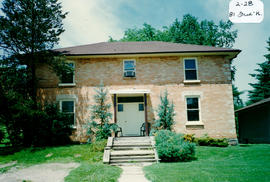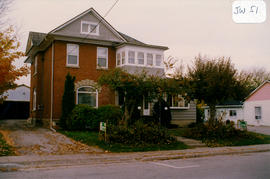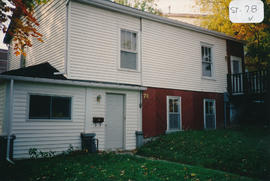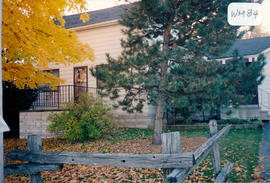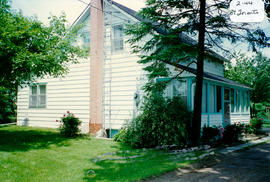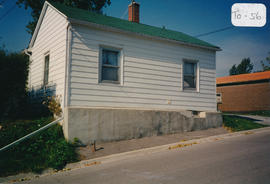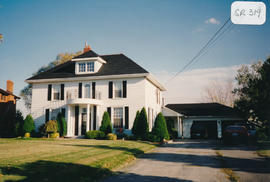The Standard Bank is located at 65 and 67 Holland St. West. It was built in the Romanesque Revival style around 1860-1900. O.M. Seim, previous owner of the Bradford Witness newspaper (1916-1932), and his family (Gordon, Ken, Marjorie, Maurice and Betty) once lived here. Dr. McMichael, a dentist, lived on John St. but had his practice here many years ago. Aubrey Stewart (and her son Bruce) at one time had an Insurance company here and the living quarters were rented. The building was eventually converted into apartments.
The commercial building (67 Holland St. W.) is set close to the street. Originally, there was a large, walk-in vault at the rear of the building on the ground floor. Residential quarters were on the second floor. The two-storey building has tall window openings with high floor to ceiling heights and an asymmetrical façade with a simplified ‘temple’ form. There is a medium-pitched, ‘pediment’ gable roof facing the front and a tympanum with a rose window. Brick pilasters support a plain cornice and frieze at both the ground and second floors to create the image of a classical Greek temple (combined with the more Roman arch form). The commercial entrance is contained within one of the two corbelled arches and is raised slightly. A double-panelled door is topped by a multi-paned transom light. The ground floor bank window is set into a corbelled arch opening with a transom light and stone or concrete lug sills. Upper windows are set into rectangular openings with transom lights. The cornice and frieze at the ground and second floors are ‘supported’ on corbelled brick brackets. This building has brick masonry construction and a cut-stone foundation.
The residential wing (65 Holland St. West) is set further back from the street to provide greater privacy to the living quarters. It takes a more recessive form with an open verandah at the ground floor and an enclosed porch on the upper floor running the full width of the house. There is a hipped roof on the residential wing. The entrance door to the house also a transom light, but like the rest of the residential wing, it does not have the rich texture or detail found on the more public portion of the building. The residential porch posts, railing, door, and windows are not original. According to the 2000 inventory, the structure is in good condition with many original details remaining. (1, 2, 3)
Please contact the Bradford West Gwillimbury Public Library (905-775-3328) if you have any other information about this photo.


